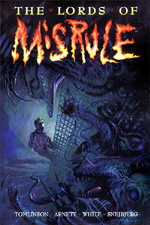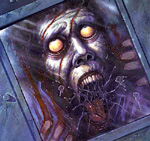>> The Friday Review: The Birthday Riots
>> The Friday Review: A Distant Soil: The Gathering
More...

"I can conceive of nothing, in religion, science or philosophy, that is more than the proper thing to wear, for a while."
- Charles Fort

To say that Charles Fort was a Renaissance man is something of an understatement. Born in Boston, he worked as a researcher in scientific literature and clashed time and again with accepted practice. Fort contested that scientists did not draw conclusions based on the evidence before them, but instead based on personal bias and the information that fitted their hypothesis best. Fort's school of thought was far more open-minded, while still retaining the scientific viewpoint. To Fort, everything was possible, unless it was proved otherwise. And it rarely was. The Fortean way of thinking created a bridge between the real and the mythical, a no man's land where either or both are true, depending on how you view a situation. This school of thought continues today, and forms the basis for several of the more interesting aspects of paranormal and scientific research.
So where, exactly does this early 20th century anomalist fit into comics? Put simply, everywhere. After all, even Superman is the survivor of a UFO crash. Batman is an urban legend made real, and Spider-Man is the victim of weird science. When viewed this way, the questions is no longer "Which comics are Fortean?" but rather, "Which comics aren't?"
Take the average country town. Throw a stone and you'll hit some history, and much of it is likely to be Fortean in nature. For example, Port St Mary, the town on the Isle of Man where I grew up, lies in the shadow of a Druidic circle on the hills. Further inland are hamlets that, to the best of my knowledge, still don't have electricity. Country towns like these are magnets for Forteana and it's from this that the two volumes of LORDS OF MISRULE draw their inspiration.
'LORDS OF MISRULE is the most Fortean of all Fortean comics.'The first, slimmer volume, written by John Tomlinson, with art by Gary Erskine, is the story of Kieron Wallace, a commercial artist with a dark past who takes a job in the small town of Callow painting covers for a local author. What he finds there forces him to face up to not only his past, but that of Callow itself. It's an interesting story, if nothing else for it's length and style. It's very short, and is in many ways a classic English horror story, populated by villages that have sat on the same spot for thousands of years and asylums inhabited by the mad and altered.
It's also a seemingly very self-contained story, and at first glance offers very little for a sequel to hang itself on. The second volume, however, puts the lie to this, and also manages to expand on Callow and it's mythology. In the second volume Tomlinson is joined by Dan Abnett and Steve White, with art by Peter Snejberg. The book picks up a few months after the end of the first volume and deals with Jack Goodfellow, an operator for a Samaritans-style phone line who was born in Callow. Events transpire to drag him back there, where he runs across not only the consequences of Wallace's actions but also the reason for his brother Vincent's murderous insanity.
The common ground between the two books is particularly interesting. Both Wallace and Goodfellow are stereotypical horror protagonists, loners with troubled pasts, faced with something they cannot understand. However, what makes the pair of them interesting is their differing approaches to their situation. Wallace continually refuses to believe the things that he sees are real, and instead insists they are the result of one of his many breakdowns. He's placed under so much stress that convincing himself he's hallucinating becomes the most comforting option. In the meantime, he is drawn further and further into Callow, until his past is merged with the village's own. He can't accept what he's experiencing as real, and is ultimately destroyed by it.
Goodfellow, on the other hand, has a far more Fortean mindset. Like Wallace he's placed under extreme stress, arguably even more so considering his past and Callow's are already linked. However, where Wallace hides in the last remaining scraps of his sanity, Goodfellow chooses to accept what he's seeing, and more importantly attempts to understand it. The ghosts become messengers, the monsters become an obstacle instead of an immovable force. Ironically, Goodfellow risks his sanity where Wallace can't and, in doing so, saves himself.

Both books walk this razor's edge throughout, with the marriage of Forteana with day-to-day life proving to be highly unsettling. Abnett and Tomlinson both realise that horror is, at its heart, subversion of the norm, and they play this idea to the absolute hilt. As a result, LORDS OF MISRULE is arguably among the most unsettling horror comics presently available. Its world is our world, one step to the left, and it's a step the reader never notices taking. It's thanks to this sort of approach that one of the most terrifying moments in both books involves nothing more than a pub sign.
Also in this respect, LORDS OF MISRULE is arguably the most Fortean of all Fortean comics. It isn't remotely monogamous with its supernatural elements, picking up everything from ghosts and time slips to other races inhabiting the Earth and prehistoric ritual sacrifice. Abnett and Tomlinson weave all these elements together and, through Callow, present us with an utterly convincing and utterly different version of our own world. The struggle to understand this sort of change is at the heart of Fortean thinking, as well as at the heart of LORDS OF MISRULE.
Of course, the fact that it's a damn good story is merely icing on the cake. LORDS OF MISRULE is a superior piece of horror in a medium flooded with substandard schlock, as well as being an extended love song to Forteana. It's intelligent, funny, scary as all hell and inherently English.

This article is Ideological Freeware. The author grants permission for its reproduction and redistribution by private individuals on condition that the author and source of the article are clearly shown, no charge is made, and the whole article is reproduced intact, including this notice.


